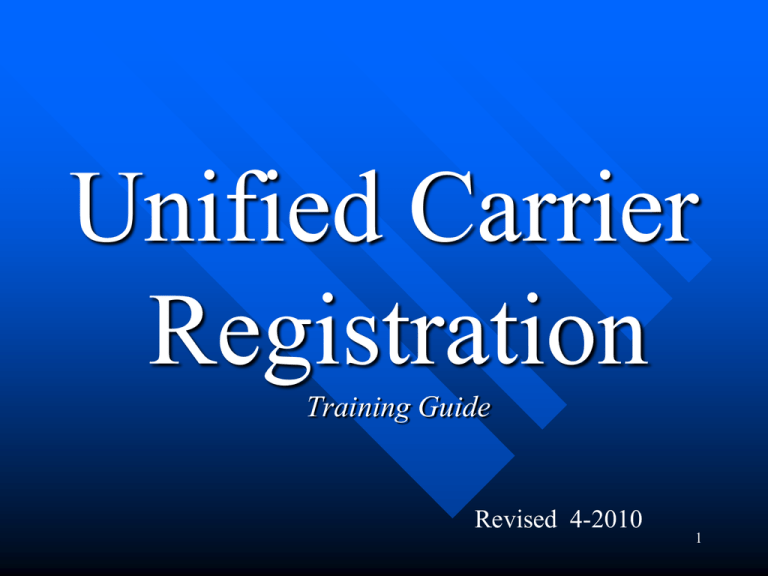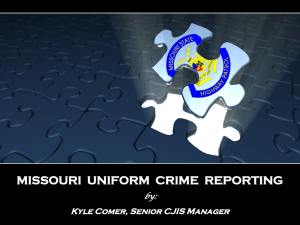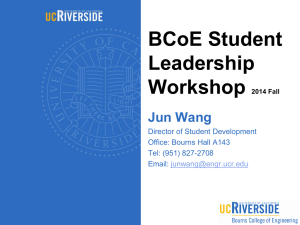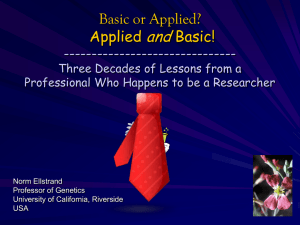UCR Training Presentation
advertisement

Unified Carrier Registration Training Guide Revised 4-2010 1 Disclaimer: The information provided here is based on the informal interpretation of the Unified Carrier Registration Act of 2005 (“UCR Act”) and is subject to further interpretation by the UCR Board. 2 Sections Definitions Who Files under the UCR Program Filing Requirements Determining the Base State How are Fees Used by the States Calculation of the Total Number of Vehicles Calculation of Fees Lease Operations State Review of an UCR Application What Happens when Fleet Size Changes Affect on Intrastate Regulation Enforcement Enforcement Scenarios You may click on any item and go to that section. 3 Definitions Return to Section Listing 4 Broker A person, other than a motor carrier or an employee or agent of a motor carrier, that as a principal or agent sells, offers for sale, negotiates for, or holds itself out by solicitation, advertisement, or otherwise as selling, providing, or arranging for, transportation by motor carrier for compensation. Note: This definition was changed by a corrections bill to SAFETEA-LU June 2008 that deleted the word commercial as defined in section 31132. 5 Combination Operations When a company has more than one type of operation, the following will apply: – Any combination of a brokers, freight forwarders and leasing companies (not combined with a motor carrier entity) file and pay the lowest tier fee. – When multiple operations include motor carrier operations, the company files as a motor carrier or motor private carrier. 6 Commercial Motor Vehicle Self-propelled vehicle used on the highways in commerce principally to transport passengers or cargo, if the vehicle: (1) Has a gross vehicle weight rating or gross vehicle weight of at least 10,001 pounds, whichever is greater; (2) Is designed to transport more than 10 passengers including the driver; or (3) Is used in transporting material found by the Secretary of Transportation to be hazardous under 49 U.S.C. Section 5103 and transported in a quantity requiring placarding under regulations prescribed by the Secretary. Note: For the registration year 2010, this definition in section 31101 was changed to exclude the words “or towed” after self-propelled. 7 Freight Forwarder An individual or company (other than as a pipeline, rail, motor, or water carrier) that receives shipments and combines them for transportation by a pipeline, rail, motor, or water carrier. 8 Leasing Company A lessor that is engaged in the business of leasing or renting for compensation motor vehicles without drivers to a motor carrier, motor private carrier, or freight forwarder. 9 Motor Carrier A person providing motor vehicle transportation for compensation. 10 Motor Private Carrier A person, other than a motor carrier, transporting property by motor vehicle when— (A) the transportation is as provided in section 13501 of this title; (B) the person is the owner, lessee, or bailee of the property being transported; and (C) the property is being transported for sale, lease, rent, or bailment or to further a commercial enterprise. Note: This definition does not include passengers. 11 Principal Place of Business A single office or terminal designated by the company ; Serves as the principal place of business; Must be a location where the company is engaged in business operations and where it maintains or can make available its business and safety records; May not be any location where the company is not engaged in business operations related to the transportation of persons or property; Post office box centers or commercial courier service establishments may not be designated; May not designate the office of a consultant, service agent, or attorney as the motor carrier's principal place of business if the company is not engaged in operations related to the transportation of persons or property at that location; A company with a single place of business may designate only its 12 actual place of business as the principal place of business. Who Files Under the UCR Program Return to Section Listing 13 Motor carriers; Motor private carriers in interstate or international commerce; Brokers; Freight forwarders; and Leasing companies. Note: Includes companies located in other countries operating through the states. See exceptions in the UCR Question and Answer document. 14 Filing Requirements Return to Section Listing 15 What is required annually? Filing of an UCR Application Payment of UCR Fees 16 Determining the Base State Return to Section Listing 17 A. Applicant registers in their principal place of business state if that state is a participating states. Note: Participating States are AK, AL, AR, CA, CO, CT, DE, GA, IA, ID, IL, IN, KS, KY, LA, MA, ME, MI, MN, MO, MS, MT, NC, ND, NE, NH, NM, NY, OH, OK, PA, RI, SC, SD, TN, TX, UT, VA, WA, WI or, WV 18 B. If the applicant is not located in a participating state, they may register in a participating state where they have an office or operating facility. C. If a participating state is geographically close to the your company’s principal place of business you may select that state. 19 D. Select a participating state (in green below) within a FMCSA region. Location Not a Participating State Select a Participating State DC,MD,NJ,VT or Province of ON,NB,NL,NS,PE,QC CT,DE,MA,ME,NH,NY,PA,RI,VA,WV Province of ON, MB,NU IA,IL,IN,KS,MI,MO,MN,NE,OH,WI FL,Mexico AZ,HI,NV,OR,WY or Province of AB,BC,MB,NT,NU,SK,YT,Mexico AL,AR,GA,KY,LA,MS,NC,OK,SC,TN,TX AK,CA,CO,ID,MT,ND,NM,SD,UT,WA 20 How are Fees Used by the States Return to Section Listing 21 UCR fees replaced the fees lost by the states with the elimination of the SSRS, Interstate exempt and combination operations renewals. The same amount of fees collected by a state must be shown to be spent by that state for safety. Many states use the UCR fee as a state match for MCSAP activities. 22 Calculation of the Total Number of Vehicles Return to Section Listing 23 Step 1. Carrier must choose the method of determining the number of motor vehicles for payment of fees: – Method 1. Number commercial motor vehicles reported on the last MCS-150; or – Method 2. Total number of commercial motor vehicles owned or operated for the 12-month period ending June 30 of the year immediately prior to registration. 24 Line 1, Section 4 of the Application Method 1. Section 26 of MCS-150 Form Column A. Total Straight Trucks, Truck Tractors and Hazmat Cargo Tank Trucks reported as owned, term leased or trip leased. 25 Line 1, Section 4 of the Application Method 1. Section 26 of MCS-150 Form Column C. Number of motor coaches, school buses, mini-buses, vans and limousines reported as owned, term leased or trip leased. 26 Line 1, Section 4 of the Application Method 2. From company’s records Column A. Total Straight Trucks, Truck Tractors and Hazmat Cargo Tank Trucks owned, term leased or trip leased during the twelve month period. Column C. Number of motor coaches, school buses, mini-buses, vans and limousines owned, term leased or trip leased during the 12 month period. Note: Registration year 2010 will look at 12 month period ending June 30, 2009. 27 Line 2, Section 4 of the Application Subtracting Vehicles – The number of vehicles on Line 1 in Column C that has a vehicle capacity of 10 or less passengers, including the driver. – (Optional) The number of vehicles that is used only in intrastate commerce. 28 Line 3, Section 4 of the Application Adding Vehicles (Optional) – Commercial motor vehicles operating solely in intrastate commerce. – Used in commerce to transport passengers or property for compensation and have a GVWR or GVW of 10,000 lbs or less, or a passenger capacity of 10 or less, including the driver. 29 Calculation of Fees Return to Section Listing 30 Section 5 – Fee Table for Year 2010 Number of Vehicles Amount Due 0-2 $76 3-5 $227 6-20 $452 21-100 $1,576 101-1000 $7,511 1001 or more $73,346 31 Lease Operations Return to Section Listing 32 Who reports leased vehicles? The lessee or motor carrier includes these vehicles where the duration of the lease if over 30 days in length. 33 State Review of an UCR Application Return to Section Listing 34 Application is complete – Section 1, General Information 1 has been completed identifying the applicant. – Section 2, Classification has at least one category has been checked. – Section 3 completed if Section 2 indicates the applicant is a broker, freight forwarder or leasing company. – Section 4. Once of the boxes need to be checked to indicate how the number of motor vehicles is being computed. 35 Application is complete (Continued) – Line1, Section 4, Information completed to get a total in column D. – Line 4, Section 4, “Total Number of Vehicles” has been calculated correctly. – Section 6, Fees Due has been calculated correctly. – Section 7, Certification has been completed. 36 Other items that may be verified at time of review – Verification of whether the company needs to file by checking » USDOT number is active or not OOS » Company Operation as shown on MCS-150 is not a registrant or intrastate only » Verification of broker or carrier’s federal operating authority is active – Prior year payment of fees have been completed if needed – Company has filed in its correct base state 37 What Happens when Fleet Size Changes Return to Section Listing 38 Scenario 1 – Decrease in fleet size that occurred after the company filed its MCS-150 form. • Companies who have vehicles that have been wrecked or no longer in the fleet are not required to make any additional filing and cannot request a refund of fees paid for those vehicles. • Prior to the filing and payment of fees for a renewal for the next registration period, the company may file an updated MCS-150 form decreasing the number of vehicles previously reported. 39 Scenario 2 – Increase in fleet size that occurred after the company filed its MCS-150 form. • Companies who have added vehicles during the current registration period are not required to pay additional fees for that registration year. • Prior to the filing of a renewal and payment of fees for the next registration period, the company may file an updated MCS-150 form increasing the number of vehicles previously reported. Note: The company is required to update its MCS-150 form every two years or every year if the company has a 40 business location in a PRISM state. Is the UCR registrant required to carry a credential on the vehicle? No. The registrants may carry the copy of the payment receipt in the vehicle if desired. 41 Affect on Intrastate Regulation Return to Section Listing 42 Intrastate Only Operations The UCR Act does not affect a State’s regulation of intrastate only carriers that do not handle interstate freight or provide interstate transportation. 43 Intrastate and Interstate Operations A State may still require an interstate carrier initially applying for intrastate authority to prove it has insurance coverage and charge it an initial application fee. A state cannot require an annual renewal of the intrastate authority if the motor carrier or motor private carrier is registered under section 13902 or section 13905(b) except for motor carriers transporting non charter passenger service, waste or recyclable materials, non-consensual tows or household goods. Note: A State cannot require an annual payment for vehicles used purely in intrastate commerce that are deleted on the UCR form 44 except as noted above. Enforcement Return to Section Listing 45 How will state agencies and the public know the registrant is compliant? SAFER System at www.safersys.org – Publicly accessed compliance data, or Inspection Selection System (ISS). 46 47 48 49 50 How often is the data in the systems updated? At a minimum states will be sending FMCSA UCR compliance information daily. FMCSA will then perform an update to their system. 51 Enforcement Scenarios Return to Section Listing 52 Question A carrier has a USDOT number (interstate) and occasionally transports freight across state lines. During a trip the carrier is moving freight between two points in the same state. They are not registered under UCR. Should a violation be listed on the inspection report for no UCR registration? 53 Answer Yes. Violation for no UCR. The requirement to register under UCR exists whether the carrier’s vehicle is loaded or empty at the time of the stop and regardless if the vehicle is crossing state lines at the time of the stop. 54 Question A carrier has a USDOT number (interstate) and is returning from dropping freight in another state. The vehicle is currently empty. The driver has no bills and his log book shows a drop in another state. The carrier is not registered under UCR. Should a violation be listed on the inspection report for no UCR registration? 55 Answer Yes. Violation for no UCR. 56 Question A carrier has a USDOT number (interstate) and is transporting freight across state lines. They claim to have registered 2 vehicles with UCR as interstate and 20 as intrastate only. The carrier is registered under UCR. It can not be determined during a roadside inspection which vehicles are registered as interstate. Should a UCR violation be listed on the inspection report? 57 Answer No Violation. 58 Question A leased vehicle is stopped for an inspection. The carrier's name and USDOT number and the leasing company's name and USDOT number are both displayed on the vehicle. Both USDOT numbers are interstate. Neither USDOT number is registered under UCR. Should a violation be listed on the inspection report? Who should the violation(s) be listed against, carrier, leasing company or both? 59 Answer Violation to carrier for no UCR. A separate violation would exist for the leasing company but how this is recorded would depend upon each respective state’s enforcement authority. 60 Enforcement Question A construction company is doing roadwork on a bridge over a river between 2 states. They drive a rubber tire crane (off-road motorized construction equipment) greater than 10,001 GVW across the state line on a daily basis. The construction company does not have a USDOT number. They only have pickup trucks less than 10,000 GVWR and use contract carriers to move material and equipment between job sites. The construction company is not registered under UCR. Is the construction company required to be registered under UCR operating off-road motorized construction equipment in interstate commerce? 61 Answer Violation to carrier for no UCR if the offroad motorized construction equipment is defined as a commercial motor vehicle. 62 Question A private carrier is transporting property across state lines in a one ton truck greater than 10,001 GVWR. They have never been registered with USDOT and have no USDOT number. The carrier is not registered under UCR. Should a violation be listed on this inspection report for no UCR registration? 63 Answer Yes. Violation to carrier for no UCR. 64 Question A for-hire bus with a maximum seating capacity of 11 people, including the driver, picks up passengers at an airport. Some of the passengers are from out of state. The passengers are transported 22 miles to a downtown drop off location. The carrier has a USDOT number (interstate) but is not registered under UCR. Should a violation be listed on this inspection report for no UCR registration? 65 Answer Yes. Violation for no UCR. 66 Question A farmer is moving grain from his farm across state lines to a processing plant. He has a USDOT number (interstate) but is not registered under UCR. Should a violation be listed on the inspection report for no UCR registered? 67 Answer Yes. Violation for no UCR . 68 Question Assuming a carrier had not paid UCR during 2007 but had paid for it for 2008. How should a violation for failing to pay 2007's UCR be written? 69 Answer Violations of UCR for prior years are entirely dependent upon an individual state’s laws. 70 Examples of roadside enforcement Example 1. Carrier: Total Trucks = 110 100 UCR registered trucks 10 exclusively intrastate not UCR registered Description of truck stopped for inspection: Apportioned plate over 26,000 lbs No IFTA Bill of lading showing interstate move Private carriage No federal authority No intrastate authority Possible enforcement action: No IFTA registration 71 Examples of roadside enforcement Example 2. Carrier: Total Trucks = 110 100 trucks not UCR registered 10 exclusively intrastate not UCR registered Description of truck stopped for inspection: Apportioned plate over 26,000 lbs IFTA Bill of lading showing interstate & intrastate moves Private carriage No federal authority No intrastate authority Possible enforcement action: No UCR registration 72 Examples of roadside enforcement Example 3. Carrier: Total Trucks = 10 No UCR registered trucks 10 exclusively intrastate not UCR registered Description of truck stopped for inspection: Straight tag No IFTA Bill of lading showing air freight move For-hire carriage No federal authority No intrastate authority Possible enforcement action: No UCR registration 73 Examples of roadside enforcement Example 4. Carrier: Total Trucks = 1 No UCR registered trucks 1 exclusively intrastate not UCR registered Description of truck stopped for inspection: Farm tag No IFTA Farmer moving his grain to local barge terminal where the movement is known to be interstate Private carriage No federal authority No intrastate authority 74 Possible enforcement action: No UCR registration Examples of roadside enforcement Example 5. Carrier: Total Trucks = 110 No UCR registered trucks 10 exclusively intrastate not UCR registered Description of truck stopped for inspection: Apportioned plate over 26,000 lbs No IFTA Bill of lading showing interstate move Private carriage No federal authority No intrastate authority Possible enforcement action: No IFTA, No UCR registration 75 Examples of roadside enforcement Example 6. Carrier: Total Trucks = 110 No UCR registered trucks 10 exclusively intrastate not UCR registered Description of truck stopped for inspection: Apportioned plate over 26,000 lbs IFTA Bill of lading showing interstate & intrastate moves For-hire carriage No federal authority No intrastate authority Possible enforcement action: No federal authority, No for-hire intrastate authority, No UCR registration 76 Examples of roadside enforcement Example 7. Carrier: Total Trucks = 110 100 UCR registered trucks 10 exclusively intrastate Description of truck stopped for inspection: Apportioned plate over 26,000 lbs IFTA Bill of lading shows intrastate move For-hire carriage No federal authority Has intrastate authority Possible enforcement action: None 77 Examples of roadside enforcement Example 8. Carrier: Total Trucks = 110 100 UCR registered trucks 10 exclusively intrastate Description of truck stopped for inspection: Out-of-state farm plate IFTA Interstate move Farmer moving for-hire No federal authority No intrastate authority Possible enforcement action: No federal authority, License 78 Plate 2009 Renewals? Fees for 2009 will be the same as 2008. MCS on-line system will be ready October 20, 2008. Missouri renewals will be mailed the same day as system is ready. State Enforcement of 2009 requirements begin January 1, 2009. 79 Additional information about the UCR program can be found at http://www.naruc.org/ncsts National UCR On-line System www.ucr.in.gov 80



